Ethical Dilemmas in Nursing: A Case Study Analysis and Recommendations
VerifiedAdded on 2020/03/16
|10
|2948
|42
Essay
AI Summary
This essay presents an analysis of a nursing ethics case study involving a physiotherapist, a surgeon, and a patient. The case highlights ethical issues such as the discontinuation of patient treatment due to a busy schedule, a surgeon working under the influence of alcohol, and the practice manager's inaction. The analysis explores ethical conflicts, professional codes of conduct, and human rights violations, including the right to the highest attainable standard of health, bodily integrity, and information. It delves into ethical principles like beneficence, autonomy, non-maleficence, and justice. The essay also offers recommendations for practice, such as informing patients about referrals, investigating professional misconduct, encouraging reporting of unethical behavior, and ensuring adequate staffing. The conclusion summarizes the ethical principles, professional standards, and human rights relevant to the case, emphasizing the need for ethical practice in healthcare.
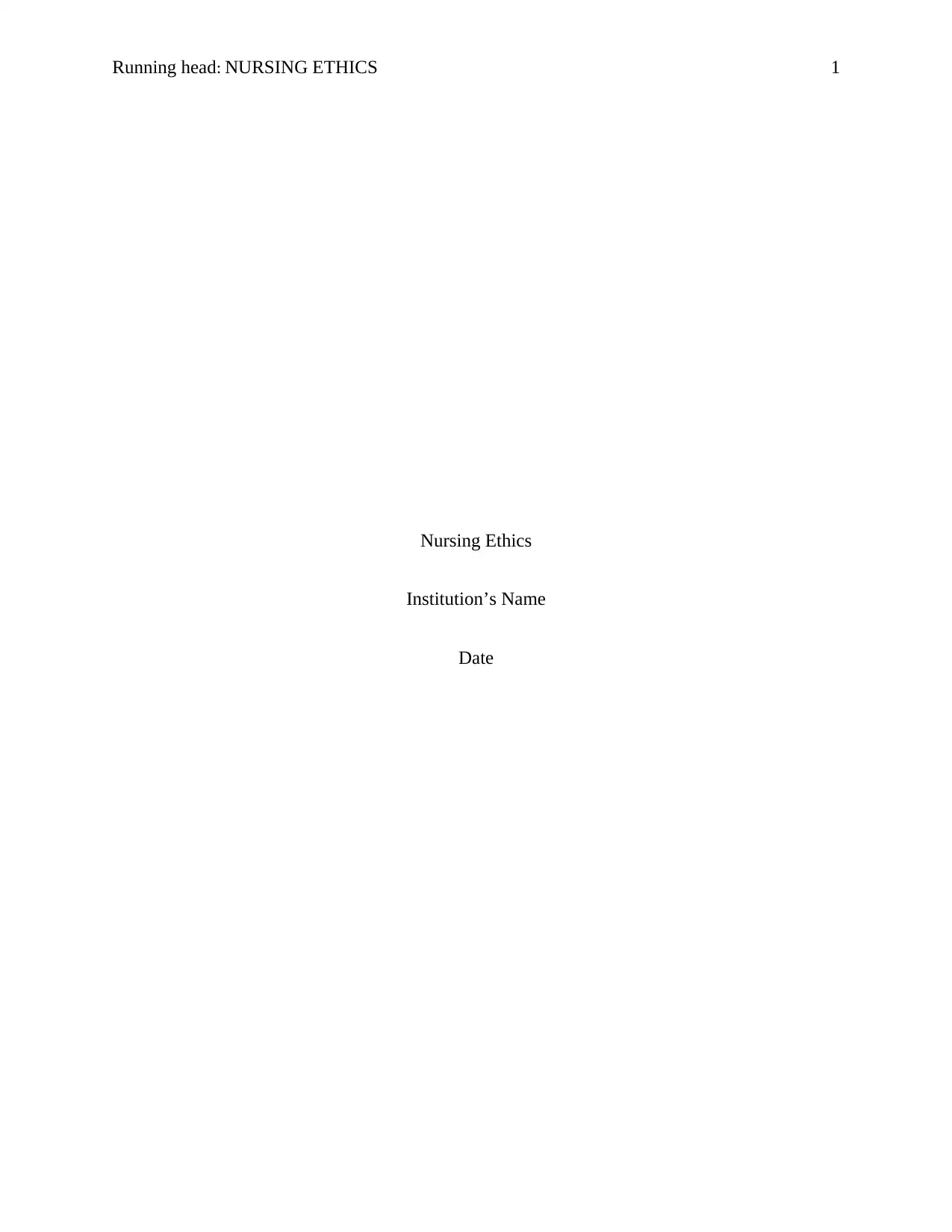
Running head: NURSING ETHICS 1
Nursing Ethics
Institution’s Name
Date
Nursing Ethics
Institution’s Name
Date
Paraphrase This Document
Need a fresh take? Get an instant paraphrase of this document with our AI Paraphraser
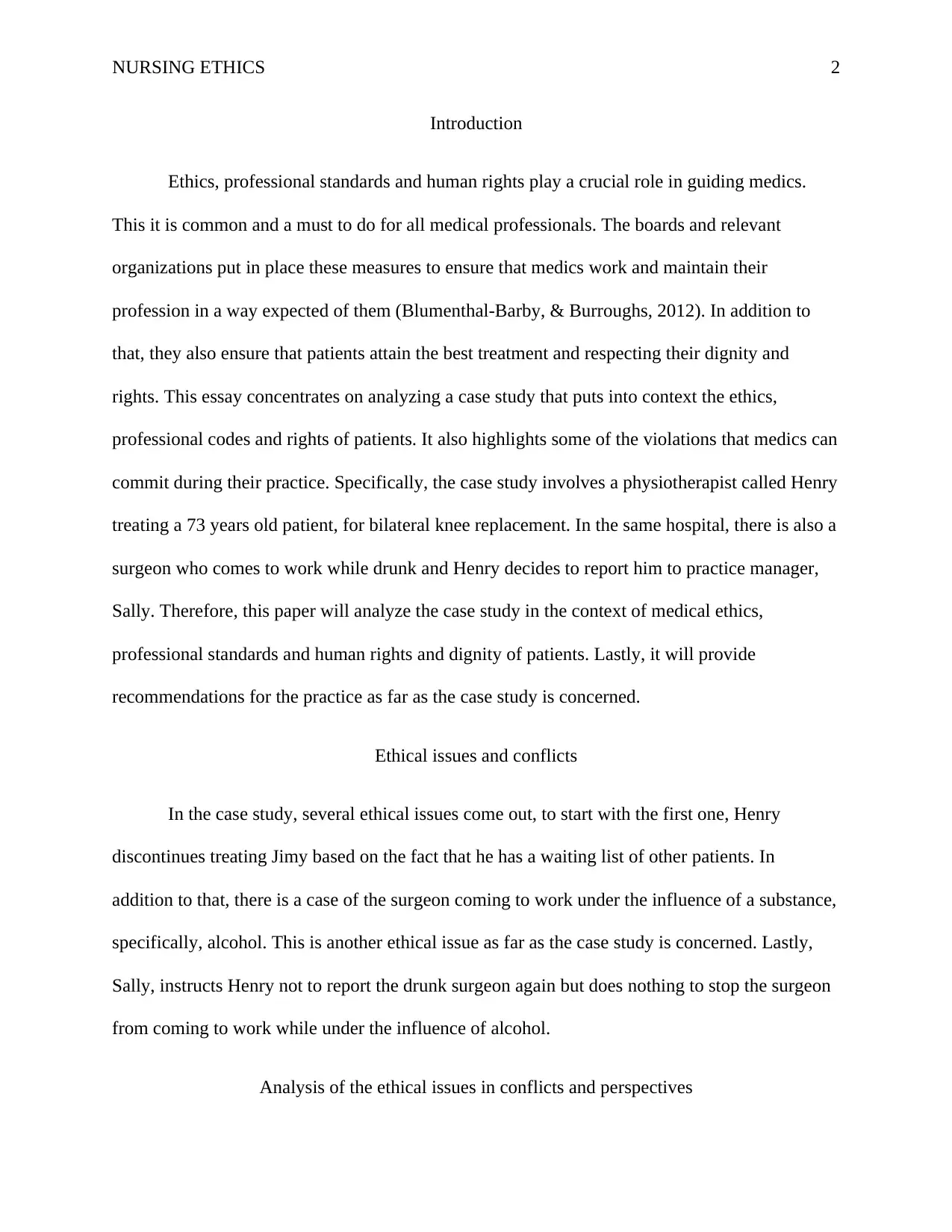
NURSING ETHICS 2
Introduction
Ethics, professional standards and human rights play a crucial role in guiding medics.
This it is common and a must to do for all medical professionals. The boards and relevant
organizations put in place these measures to ensure that medics work and maintain their
profession in a way expected of them (Blumenthal-Barby, & Burroughs, 2012). In addition to
that, they also ensure that patients attain the best treatment and respecting their dignity and
rights. This essay concentrates on analyzing a case study that puts into context the ethics,
professional codes and rights of patients. It also highlights some of the violations that medics can
commit during their practice. Specifically, the case study involves a physiotherapist called Henry
treating a 73 years old patient, for bilateral knee replacement. In the same hospital, there is also a
surgeon who comes to work while drunk and Henry decides to report him to practice manager,
Sally. Therefore, this paper will analyze the case study in the context of medical ethics,
professional standards and human rights and dignity of patients. Lastly, it will provide
recommendations for the practice as far as the case study is concerned.
Ethical issues and conflicts
In the case study, several ethical issues come out, to start with the first one, Henry
discontinues treating Jimy based on the fact that he has a waiting list of other patients. In
addition to that, there is a case of the surgeon coming to work under the influence of a substance,
specifically, alcohol. This is another ethical issue as far as the case study is concerned. Lastly,
Sally, instructs Henry not to report the drunk surgeon again but does nothing to stop the surgeon
from coming to work while under the influence of alcohol.
Analysis of the ethical issues in conflicts and perspectives
Introduction
Ethics, professional standards and human rights play a crucial role in guiding medics.
This it is common and a must to do for all medical professionals. The boards and relevant
organizations put in place these measures to ensure that medics work and maintain their
profession in a way expected of them (Blumenthal-Barby, & Burroughs, 2012). In addition to
that, they also ensure that patients attain the best treatment and respecting their dignity and
rights. This essay concentrates on analyzing a case study that puts into context the ethics,
professional codes and rights of patients. It also highlights some of the violations that medics can
commit during their practice. Specifically, the case study involves a physiotherapist called Henry
treating a 73 years old patient, for bilateral knee replacement. In the same hospital, there is also a
surgeon who comes to work while drunk and Henry decides to report him to practice manager,
Sally. Therefore, this paper will analyze the case study in the context of medical ethics,
professional standards and human rights and dignity of patients. Lastly, it will provide
recommendations for the practice as far as the case study is concerned.
Ethical issues and conflicts
In the case study, several ethical issues come out, to start with the first one, Henry
discontinues treating Jimy based on the fact that he has a waiting list of other patients. In
addition to that, there is a case of the surgeon coming to work under the influence of a substance,
specifically, alcohol. This is another ethical issue as far as the case study is concerned. Lastly,
Sally, instructs Henry not to report the drunk surgeon again but does nothing to stop the surgeon
from coming to work while under the influence of alcohol.
Analysis of the ethical issues in conflicts and perspectives
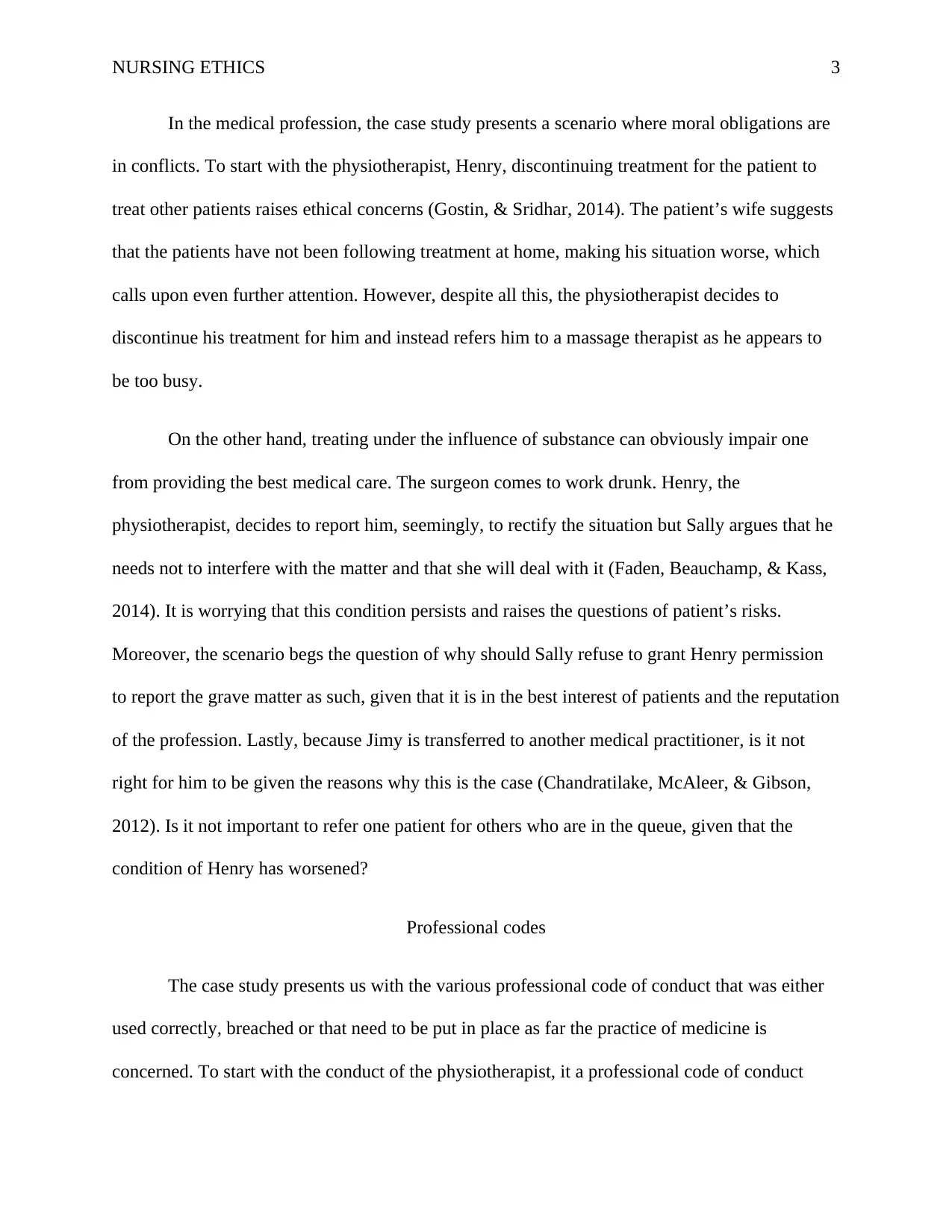
NURSING ETHICS 3
In the medical profession, the case study presents a scenario where moral obligations are
in conflicts. To start with the physiotherapist, Henry, discontinuing treatment for the patient to
treat other patients raises ethical concerns (Gostin, & Sridhar, 2014). The patient’s wife suggests
that the patients have not been following treatment at home, making his situation worse, which
calls upon even further attention. However, despite all this, the physiotherapist decides to
discontinue his treatment for him and instead refers him to a massage therapist as he appears to
be too busy.
On the other hand, treating under the influence of substance can obviously impair one
from providing the best medical care. The surgeon comes to work drunk. Henry, the
physiotherapist, decides to report him, seemingly, to rectify the situation but Sally argues that he
needs not to interfere with the matter and that she will deal with it (Faden, Beauchamp, & Kass,
2014). It is worrying that this condition persists and raises the questions of patient’s risks.
Moreover, the scenario begs the question of why should Sally refuse to grant Henry permission
to report the grave matter as such, given that it is in the best interest of patients and the reputation
of the profession. Lastly, because Jimy is transferred to another medical practitioner, is it not
right for him to be given the reasons why this is the case (Chandratilake, McAleer, & Gibson,
2012). Is it not important to refer one patient for others who are in the queue, given that the
condition of Henry has worsened?
Professional codes
The case study presents us with the various professional code of conduct that was either
used correctly, breached or that need to be put in place as far the practice of medicine is
concerned. To start with the conduct of the physiotherapist, it a professional code of conduct
In the medical profession, the case study presents a scenario where moral obligations are
in conflicts. To start with the physiotherapist, Henry, discontinuing treatment for the patient to
treat other patients raises ethical concerns (Gostin, & Sridhar, 2014). The patient’s wife suggests
that the patients have not been following treatment at home, making his situation worse, which
calls upon even further attention. However, despite all this, the physiotherapist decides to
discontinue his treatment for him and instead refers him to a massage therapist as he appears to
be too busy.
On the other hand, treating under the influence of substance can obviously impair one
from providing the best medical care. The surgeon comes to work drunk. Henry, the
physiotherapist, decides to report him, seemingly, to rectify the situation but Sally argues that he
needs not to interfere with the matter and that she will deal with it (Faden, Beauchamp, & Kass,
2014). It is worrying that this condition persists and raises the questions of patient’s risks.
Moreover, the scenario begs the question of why should Sally refuse to grant Henry permission
to report the grave matter as such, given that it is in the best interest of patients and the reputation
of the profession. Lastly, because Jimy is transferred to another medical practitioner, is it not
right for him to be given the reasons why this is the case (Chandratilake, McAleer, & Gibson,
2012). Is it not important to refer one patient for others who are in the queue, given that the
condition of Henry has worsened?
Professional codes
The case study presents us with the various professional code of conduct that was either
used correctly, breached or that need to be put in place as far the practice of medicine is
concerned. To start with the conduct of the physiotherapist, it a professional code of conduct
⊘ This is a preview!⊘
Do you want full access?
Subscribe today to unlock all pages.

Trusted by 1+ million students worldwide
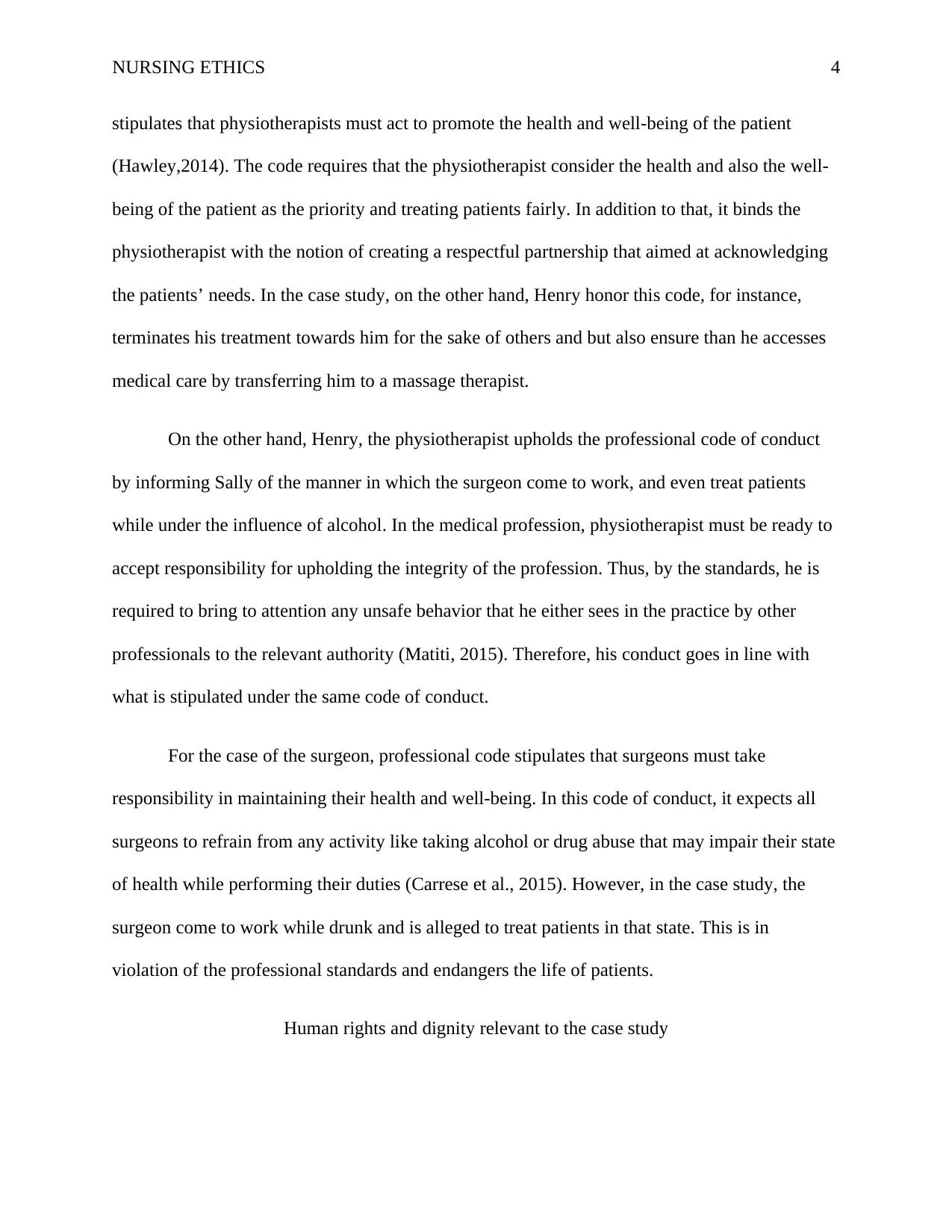
NURSING ETHICS 4
stipulates that physiotherapists must act to promote the health and well-being of the patient
(Hawley,2014). The code requires that the physiotherapist consider the health and also the well-
being of the patient as the priority and treating patients fairly. In addition to that, it binds the
physiotherapist with the notion of creating a respectful partnership that aimed at acknowledging
the patients’ needs. In the case study, on the other hand, Henry honor this code, for instance,
terminates his treatment towards him for the sake of others and but also ensure than he accesses
medical care by transferring him to a massage therapist.
On the other hand, Henry, the physiotherapist upholds the professional code of conduct
by informing Sally of the manner in which the surgeon come to work, and even treat patients
while under the influence of alcohol. In the medical profession, physiotherapist must be ready to
accept responsibility for upholding the integrity of the profession. Thus, by the standards, he is
required to bring to attention any unsafe behavior that he either sees in the practice by other
professionals to the relevant authority (Matiti, 2015). Therefore, his conduct goes in line with
what is stipulated under the same code of conduct.
For the case of the surgeon, professional code stipulates that surgeons must take
responsibility in maintaining their health and well-being. In this code of conduct, it expects all
surgeons to refrain from any activity like taking alcohol or drug abuse that may impair their state
of health while performing their duties (Carrese et al., 2015). However, in the case study, the
surgeon come to work while drunk and is alleged to treat patients in that state. This is in
violation of the professional standards and endangers the life of patients.
Human rights and dignity relevant to the case study
stipulates that physiotherapists must act to promote the health and well-being of the patient
(Hawley,2014). The code requires that the physiotherapist consider the health and also the well-
being of the patient as the priority and treating patients fairly. In addition to that, it binds the
physiotherapist with the notion of creating a respectful partnership that aimed at acknowledging
the patients’ needs. In the case study, on the other hand, Henry honor this code, for instance,
terminates his treatment towards him for the sake of others and but also ensure than he accesses
medical care by transferring him to a massage therapist.
On the other hand, Henry, the physiotherapist upholds the professional code of conduct
by informing Sally of the manner in which the surgeon come to work, and even treat patients
while under the influence of alcohol. In the medical profession, physiotherapist must be ready to
accept responsibility for upholding the integrity of the profession. Thus, by the standards, he is
required to bring to attention any unsafe behavior that he either sees in the practice by other
professionals to the relevant authority (Matiti, 2015). Therefore, his conduct goes in line with
what is stipulated under the same code of conduct.
For the case of the surgeon, professional code stipulates that surgeons must take
responsibility in maintaining their health and well-being. In this code of conduct, it expects all
surgeons to refrain from any activity like taking alcohol or drug abuse that may impair their state
of health while performing their duties (Carrese et al., 2015). However, in the case study, the
surgeon come to work while drunk and is alleged to treat patients in that state. This is in
violation of the professional standards and endangers the life of patients.
Human rights and dignity relevant to the case study
Paraphrase This Document
Need a fresh take? Get an instant paraphrase of this document with our AI Paraphraser
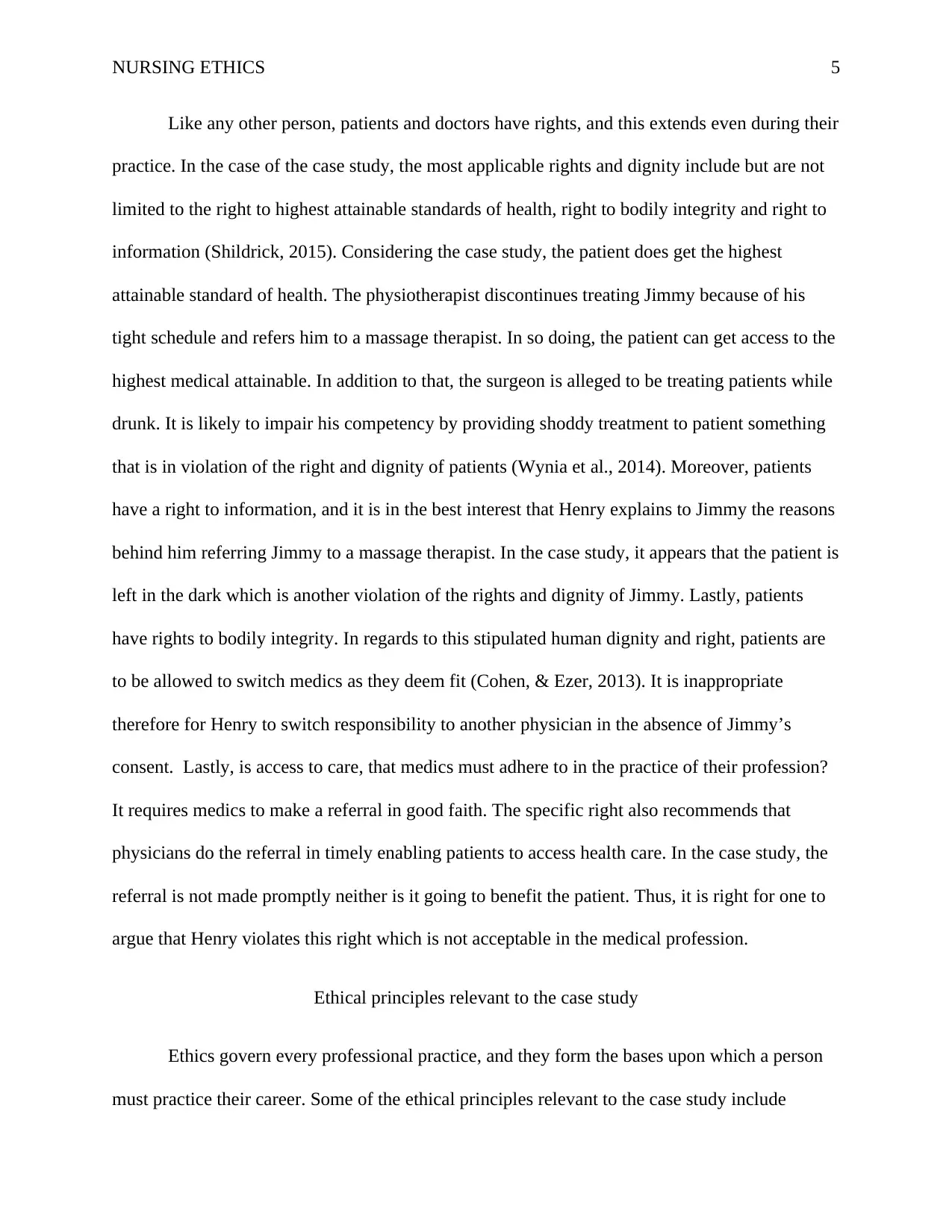
NURSING ETHICS 5
Like any other person, patients and doctors have rights, and this extends even during their
practice. In the case of the case study, the most applicable rights and dignity include but are not
limited to the right to highest attainable standards of health, right to bodily integrity and right to
information (Shildrick, 2015). Considering the case study, the patient does get the highest
attainable standard of health. The physiotherapist discontinues treating Jimmy because of his
tight schedule and refers him to a massage therapist. In so doing, the patient can get access to the
highest medical attainable. In addition to that, the surgeon is alleged to be treating patients while
drunk. It is likely to impair his competency by providing shoddy treatment to patient something
that is in violation of the right and dignity of patients (Wynia et al., 2014). Moreover, patients
have a right to information, and it is in the best interest that Henry explains to Jimmy the reasons
behind him referring Jimmy to a massage therapist. In the case study, it appears that the patient is
left in the dark which is another violation of the rights and dignity of Jimmy. Lastly, patients
have rights to bodily integrity. In regards to this stipulated human dignity and right, patients are
to be allowed to switch medics as they deem fit (Cohen, & Ezer, 2013). It is inappropriate
therefore for Henry to switch responsibility to another physician in the absence of Jimmy’s
consent. Lastly, is access to care, that medics must adhere to in the practice of their profession?
It requires medics to make a referral in good faith. The specific right also recommends that
physicians do the referral in timely enabling patients to access health care. In the case study, the
referral is not made promptly neither is it going to benefit the patient. Thus, it is right for one to
argue that Henry violates this right which is not acceptable in the medical profession.
Ethical principles relevant to the case study
Ethics govern every professional practice, and they form the bases upon which a person
must practice their career. Some of the ethical principles relevant to the case study include
Like any other person, patients and doctors have rights, and this extends even during their
practice. In the case of the case study, the most applicable rights and dignity include but are not
limited to the right to highest attainable standards of health, right to bodily integrity and right to
information (Shildrick, 2015). Considering the case study, the patient does get the highest
attainable standard of health. The physiotherapist discontinues treating Jimmy because of his
tight schedule and refers him to a massage therapist. In so doing, the patient can get access to the
highest medical attainable. In addition to that, the surgeon is alleged to be treating patients while
drunk. It is likely to impair his competency by providing shoddy treatment to patient something
that is in violation of the right and dignity of patients (Wynia et al., 2014). Moreover, patients
have a right to information, and it is in the best interest that Henry explains to Jimmy the reasons
behind him referring Jimmy to a massage therapist. In the case study, it appears that the patient is
left in the dark which is another violation of the rights and dignity of Jimmy. Lastly, patients
have rights to bodily integrity. In regards to this stipulated human dignity and right, patients are
to be allowed to switch medics as they deem fit (Cohen, & Ezer, 2013). It is inappropriate
therefore for Henry to switch responsibility to another physician in the absence of Jimmy’s
consent. Lastly, is access to care, that medics must adhere to in the practice of their profession?
It requires medics to make a referral in good faith. The specific right also recommends that
physicians do the referral in timely enabling patients to access health care. In the case study, the
referral is not made promptly neither is it going to benefit the patient. Thus, it is right for one to
argue that Henry violates this right which is not acceptable in the medical profession.
Ethical principles relevant to the case study
Ethics govern every professional practice, and they form the bases upon which a person
must practice their career. Some of the ethical principles relevant to the case study include
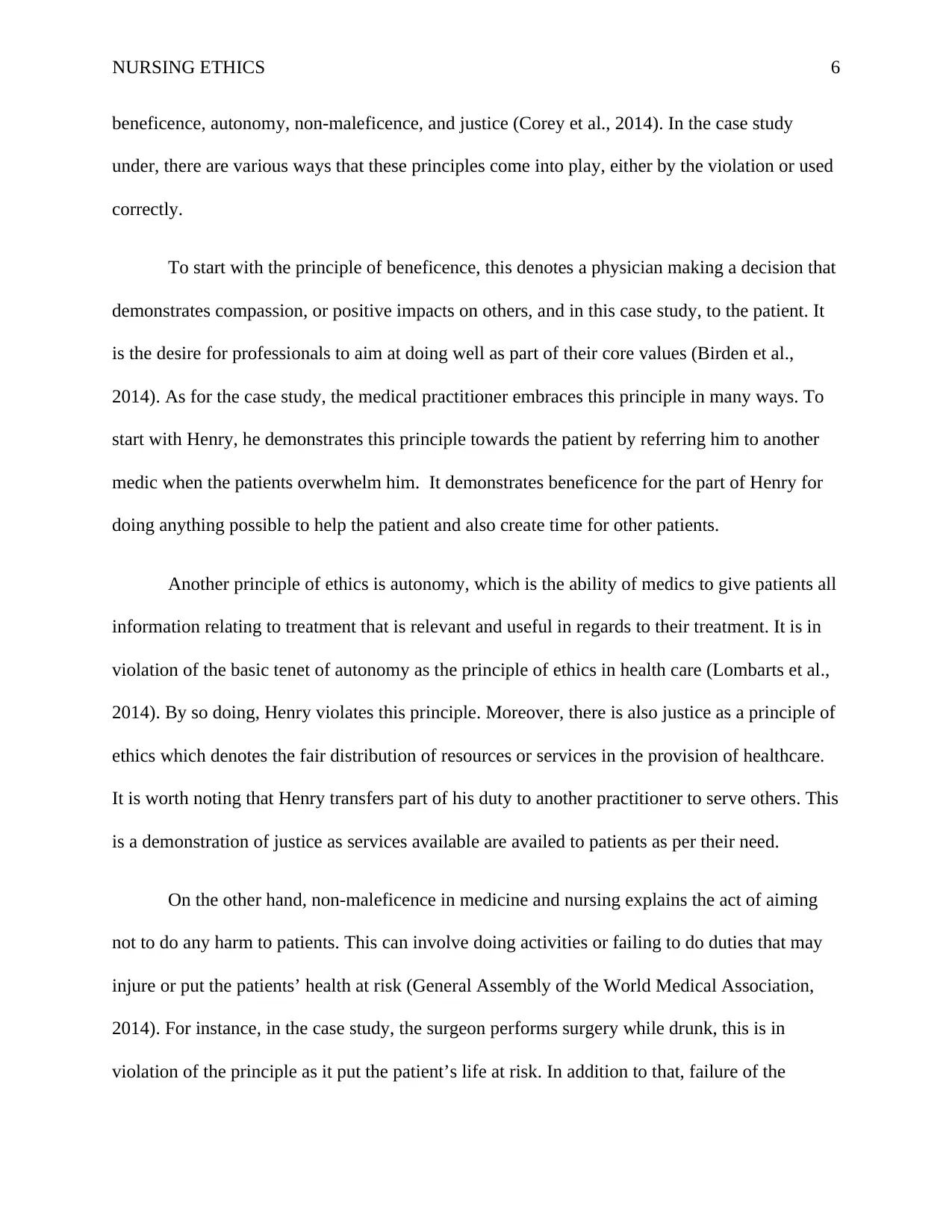
NURSING ETHICS 6
beneficence, autonomy, non-maleficence, and justice (Corey et al., 2014). In the case study
under, there are various ways that these principles come into play, either by the violation or used
correctly.
To start with the principle of beneficence, this denotes a physician making a decision that
demonstrates compassion, or positive impacts on others, and in this case study, to the patient. It
is the desire for professionals to aim at doing well as part of their core values (Birden et al.,
2014). As for the case study, the medical practitioner embraces this principle in many ways. To
start with Henry, he demonstrates this principle towards the patient by referring him to another
medic when the patients overwhelm him. It demonstrates beneficence for the part of Henry for
doing anything possible to help the patient and also create time for other patients.
Another principle of ethics is autonomy, which is the ability of medics to give patients all
information relating to treatment that is relevant and useful in regards to their treatment. It is in
violation of the basic tenet of autonomy as the principle of ethics in health care (Lombarts et al.,
2014). By so doing, Henry violates this principle. Moreover, there is also justice as a principle of
ethics which denotes the fair distribution of resources or services in the provision of healthcare.
It is worth noting that Henry transfers part of his duty to another practitioner to serve others. This
is a demonstration of justice as services available are availed to patients as per their need.
On the other hand, non-maleficence in medicine and nursing explains the act of aiming
not to do any harm to patients. This can involve doing activities or failing to do duties that may
injure or put the patients’ health at risk (General Assembly of the World Medical Association,
2014). For instance, in the case study, the surgeon performs surgery while drunk, this is in
violation of the principle as it put the patient’s life at risk. In addition to that, failure of the
beneficence, autonomy, non-maleficence, and justice (Corey et al., 2014). In the case study
under, there are various ways that these principles come into play, either by the violation or used
correctly.
To start with the principle of beneficence, this denotes a physician making a decision that
demonstrates compassion, or positive impacts on others, and in this case study, to the patient. It
is the desire for professionals to aim at doing well as part of their core values (Birden et al.,
2014). As for the case study, the medical practitioner embraces this principle in many ways. To
start with Henry, he demonstrates this principle towards the patient by referring him to another
medic when the patients overwhelm him. It demonstrates beneficence for the part of Henry for
doing anything possible to help the patient and also create time for other patients.
Another principle of ethics is autonomy, which is the ability of medics to give patients all
information relating to treatment that is relevant and useful in regards to their treatment. It is in
violation of the basic tenet of autonomy as the principle of ethics in health care (Lombarts et al.,
2014). By so doing, Henry violates this principle. Moreover, there is also justice as a principle of
ethics which denotes the fair distribution of resources or services in the provision of healthcare.
It is worth noting that Henry transfers part of his duty to another practitioner to serve others. This
is a demonstration of justice as services available are availed to patients as per their need.
On the other hand, non-maleficence in medicine and nursing explains the act of aiming
not to do any harm to patients. This can involve doing activities or failing to do duties that may
injure or put the patients’ health at risk (General Assembly of the World Medical Association,
2014). For instance, in the case study, the surgeon performs surgery while drunk, this is in
violation of the principle as it put the patient’s life at risk. In addition to that, failure of the
⊘ This is a preview!⊘
Do you want full access?
Subscribe today to unlock all pages.

Trusted by 1+ million students worldwide
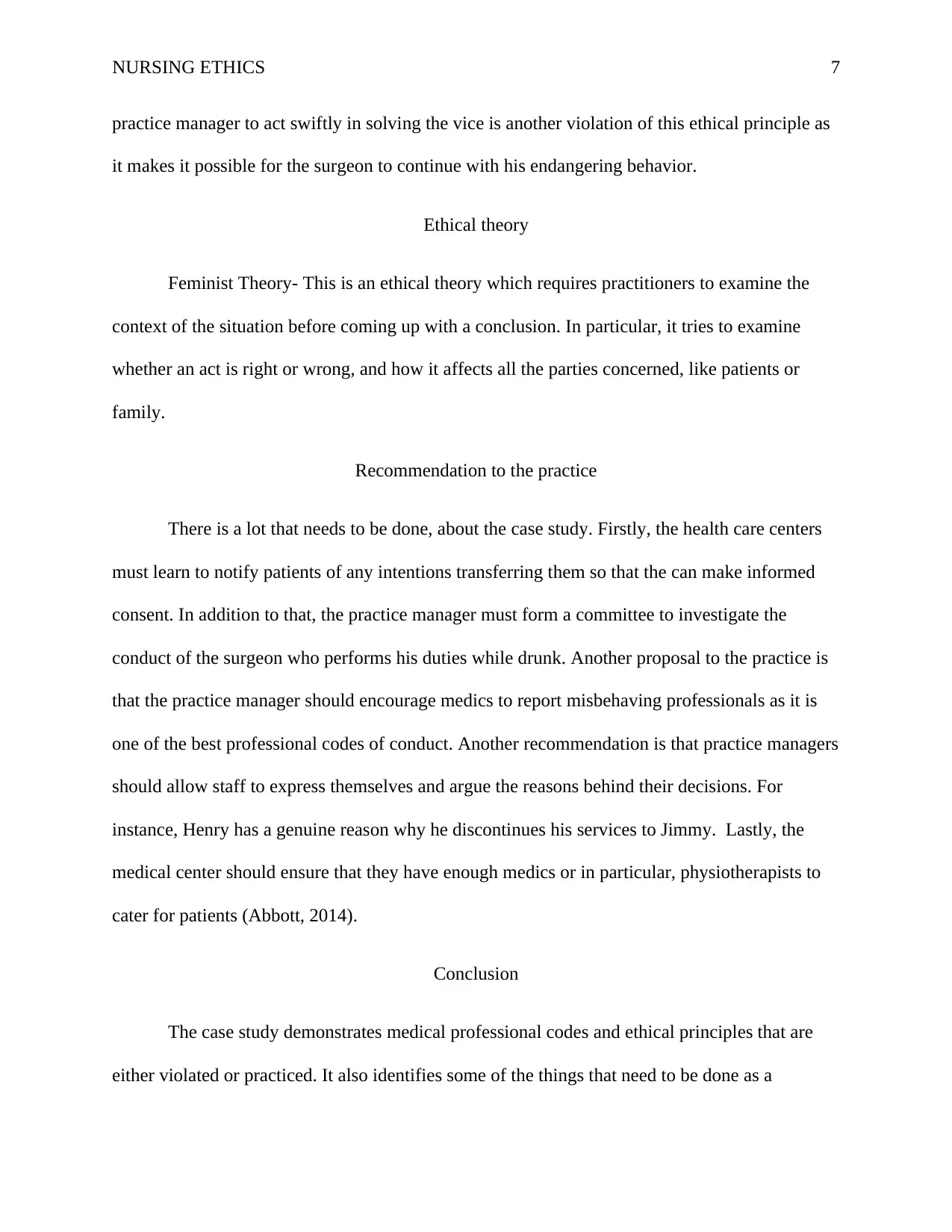
NURSING ETHICS 7
practice manager to act swiftly in solving the vice is another violation of this ethical principle as
it makes it possible for the surgeon to continue with his endangering behavior.
Ethical theory
Feminist Theory- This is an ethical theory which requires practitioners to examine the
context of the situation before coming up with a conclusion. In particular, it tries to examine
whether an act is right or wrong, and how it affects all the parties concerned, like patients or
family.
Recommendation to the practice
There is a lot that needs to be done, about the case study. Firstly, the health care centers
must learn to notify patients of any intentions transferring them so that the can make informed
consent. In addition to that, the practice manager must form a committee to investigate the
conduct of the surgeon who performs his duties while drunk. Another proposal to the practice is
that the practice manager should encourage medics to report misbehaving professionals as it is
one of the best professional codes of conduct. Another recommendation is that practice managers
should allow staff to express themselves and argue the reasons behind their decisions. For
instance, Henry has a genuine reason why he discontinues his services to Jimmy. Lastly, the
medical center should ensure that they have enough medics or in particular, physiotherapists to
cater for patients (Abbott, 2014).
Conclusion
The case study demonstrates medical professional codes and ethical principles that are
either violated or practiced. It also identifies some of the things that need to be done as a
practice manager to act swiftly in solving the vice is another violation of this ethical principle as
it makes it possible for the surgeon to continue with his endangering behavior.
Ethical theory
Feminist Theory- This is an ethical theory which requires practitioners to examine the
context of the situation before coming up with a conclusion. In particular, it tries to examine
whether an act is right or wrong, and how it affects all the parties concerned, like patients or
family.
Recommendation to the practice
There is a lot that needs to be done, about the case study. Firstly, the health care centers
must learn to notify patients of any intentions transferring them so that the can make informed
consent. In addition to that, the practice manager must form a committee to investigate the
conduct of the surgeon who performs his duties while drunk. Another proposal to the practice is
that the practice manager should encourage medics to report misbehaving professionals as it is
one of the best professional codes of conduct. Another recommendation is that practice managers
should allow staff to express themselves and argue the reasons behind their decisions. For
instance, Henry has a genuine reason why he discontinues his services to Jimmy. Lastly, the
medical center should ensure that they have enough medics or in particular, physiotherapists to
cater for patients (Abbott, 2014).
Conclusion
The case study demonstrates medical professional codes and ethical principles that are
either violated or practiced. It also identifies some of the things that need to be done as a
Paraphrase This Document
Need a fresh take? Get an instant paraphrase of this document with our AI Paraphraser
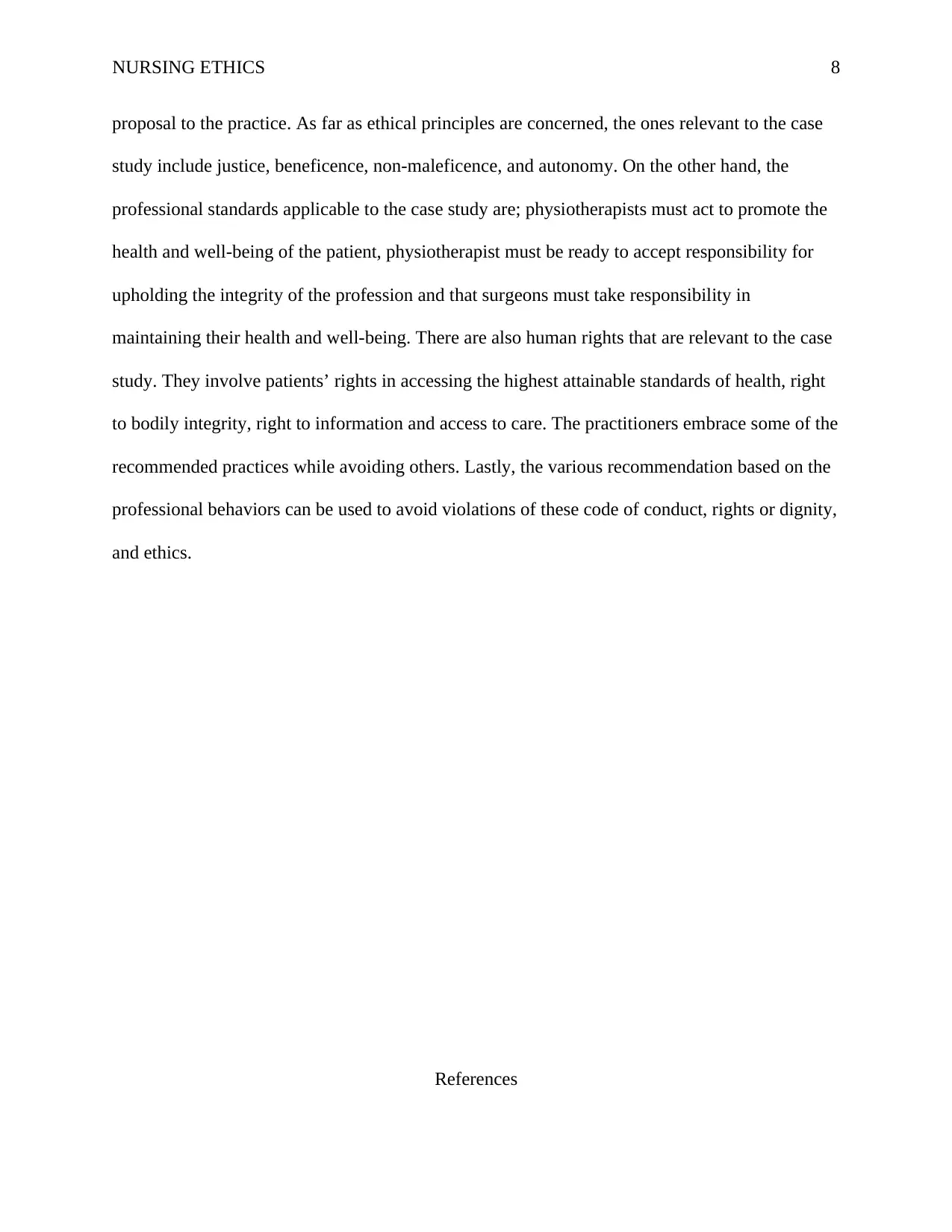
NURSING ETHICS 8
proposal to the practice. As far as ethical principles are concerned, the ones relevant to the case
study include justice, beneficence, non-maleficence, and autonomy. On the other hand, the
professional standards applicable to the case study are; physiotherapists must act to promote the
health and well-being of the patient, physiotherapist must be ready to accept responsibility for
upholding the integrity of the profession and that surgeons must take responsibility in
maintaining their health and well-being. There are also human rights that are relevant to the case
study. They involve patients’ rights in accessing the highest attainable standards of health, right
to bodily integrity, right to information and access to care. The practitioners embrace some of the
recommended practices while avoiding others. Lastly, the various recommendation based on the
professional behaviors can be used to avoid violations of these code of conduct, rights or dignity,
and ethics.
References
proposal to the practice. As far as ethical principles are concerned, the ones relevant to the case
study include justice, beneficence, non-maleficence, and autonomy. On the other hand, the
professional standards applicable to the case study are; physiotherapists must act to promote the
health and well-being of the patient, physiotherapist must be ready to accept responsibility for
upholding the integrity of the profession and that surgeons must take responsibility in
maintaining their health and well-being. There are also human rights that are relevant to the case
study. They involve patients’ rights in accessing the highest attainable standards of health, right
to bodily integrity, right to information and access to care. The practitioners embrace some of the
recommended practices while avoiding others. Lastly, the various recommendation based on the
professional behaviors can be used to avoid violations of these code of conduct, rights or dignity,
and ethics.
References
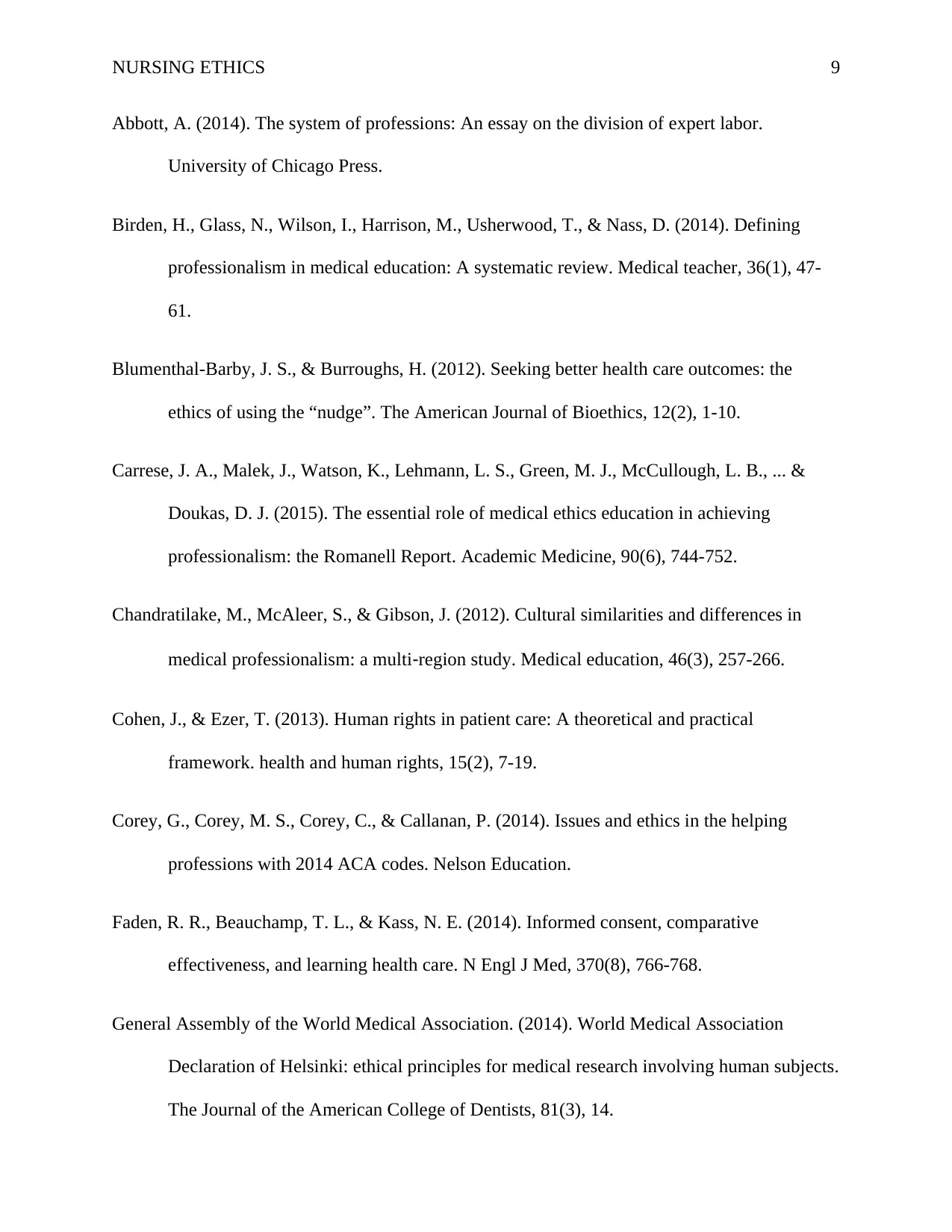
NURSING ETHICS 9
Abbott, A. (2014). The system of professions: An essay on the division of expert labor.
University of Chicago Press.
Birden, H., Glass, N., Wilson, I., Harrison, M., Usherwood, T., & Nass, D. (2014). Defining
professionalism in medical education: A systematic review. Medical teacher, 36(1), 47-
61.
Blumenthal-Barby, J. S., & Burroughs, H. (2012). Seeking better health care outcomes: the
ethics of using the “nudge”. The American Journal of Bioethics, 12(2), 1-10.
Carrese, J. A., Malek, J., Watson, K., Lehmann, L. S., Green, M. J., McCullough, L. B., ... &
Doukas, D. J. (2015). The essential role of medical ethics education in achieving
professionalism: the Romanell Report. Academic Medicine, 90(6), 744-752.
Chandratilake, M., McAleer, S., & Gibson, J. (2012). Cultural similarities and differences in
medical professionalism: a multi‐region study. Medical education, 46(3), 257-266.
Cohen, J., & Ezer, T. (2013). Human rights in patient care: A theoretical and practical
framework. health and human rights, 15(2), 7-19.
Corey, G., Corey, M. S., Corey, C., & Callanan, P. (2014). Issues and ethics in the helping
professions with 2014 ACA codes. Nelson Education.
Faden, R. R., Beauchamp, T. L., & Kass, N. E. (2014). Informed consent, comparative
effectiveness, and learning health care. N Engl J Med, 370(8), 766-768.
General Assembly of the World Medical Association. (2014). World Medical Association
Declaration of Helsinki: ethical principles for medical research involving human subjects.
The Journal of the American College of Dentists, 81(3), 14.
Abbott, A. (2014). The system of professions: An essay on the division of expert labor.
University of Chicago Press.
Birden, H., Glass, N., Wilson, I., Harrison, M., Usherwood, T., & Nass, D. (2014). Defining
professionalism in medical education: A systematic review. Medical teacher, 36(1), 47-
61.
Blumenthal-Barby, J. S., & Burroughs, H. (2012). Seeking better health care outcomes: the
ethics of using the “nudge”. The American Journal of Bioethics, 12(2), 1-10.
Carrese, J. A., Malek, J., Watson, K., Lehmann, L. S., Green, M. J., McCullough, L. B., ... &
Doukas, D. J. (2015). The essential role of medical ethics education in achieving
professionalism: the Romanell Report. Academic Medicine, 90(6), 744-752.
Chandratilake, M., McAleer, S., & Gibson, J. (2012). Cultural similarities and differences in
medical professionalism: a multi‐region study. Medical education, 46(3), 257-266.
Cohen, J., & Ezer, T. (2013). Human rights in patient care: A theoretical and practical
framework. health and human rights, 15(2), 7-19.
Corey, G., Corey, M. S., Corey, C., & Callanan, P. (2014). Issues and ethics in the helping
professions with 2014 ACA codes. Nelson Education.
Faden, R. R., Beauchamp, T. L., & Kass, N. E. (2014). Informed consent, comparative
effectiveness, and learning health care. N Engl J Med, 370(8), 766-768.
General Assembly of the World Medical Association. (2014). World Medical Association
Declaration of Helsinki: ethical principles for medical research involving human subjects.
The Journal of the American College of Dentists, 81(3), 14.
⊘ This is a preview!⊘
Do you want full access?
Subscribe today to unlock all pages.

Trusted by 1+ million students worldwide
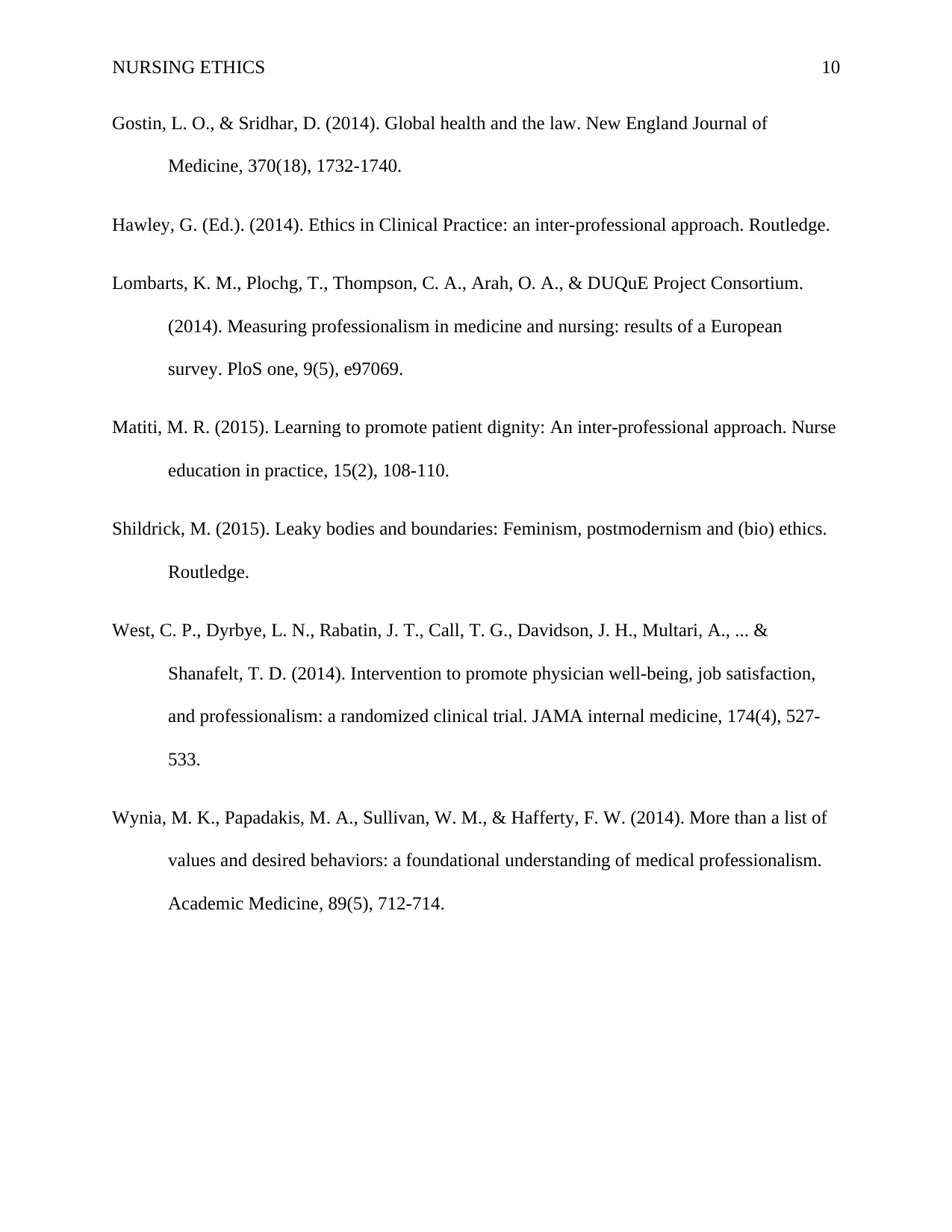
NURSING ETHICS 10
Gostin, L. O., & Sridhar, D. (2014). Global health and the law. New England Journal of
Medicine, 370(18), 1732-1740.
Hawley, G. (Ed.). (2014). Ethics in Clinical Practice: an inter-professional approach. Routledge.
Lombarts, K. M., Plochg, T., Thompson, C. A., Arah, O. A., & DUQuE Project Consortium.
(2014). Measuring professionalism in medicine and nursing: results of a European
survey. PloS one, 9(5), e97069.
Matiti, M. R. (2015). Learning to promote patient dignity: An inter-professional approach. Nurse
education in practice, 15(2), 108-110.
Shildrick, M. (2015). Leaky bodies and boundaries: Feminism, postmodernism and (bio) ethics.
Routledge.
West, C. P., Dyrbye, L. N., Rabatin, J. T., Call, T. G., Davidson, J. H., Multari, A., ... &
Shanafelt, T. D. (2014). Intervention to promote physician well-being, job satisfaction,
and professionalism: a randomized clinical trial. JAMA internal medicine, 174(4), 527-
533.
Wynia, M. K., Papadakis, M. A., Sullivan, W. M., & Hafferty, F. W. (2014). More than a list of
values and desired behaviors: a foundational understanding of medical professionalism.
Academic Medicine, 89(5), 712-714.
Gostin, L. O., & Sridhar, D. (2014). Global health and the law. New England Journal of
Medicine, 370(18), 1732-1740.
Hawley, G. (Ed.). (2014). Ethics in Clinical Practice: an inter-professional approach. Routledge.
Lombarts, K. M., Plochg, T., Thompson, C. A., Arah, O. A., & DUQuE Project Consortium.
(2014). Measuring professionalism in medicine and nursing: results of a European
survey. PloS one, 9(5), e97069.
Matiti, M. R. (2015). Learning to promote patient dignity: An inter-professional approach. Nurse
education in practice, 15(2), 108-110.
Shildrick, M. (2015). Leaky bodies and boundaries: Feminism, postmodernism and (bio) ethics.
Routledge.
West, C. P., Dyrbye, L. N., Rabatin, J. T., Call, T. G., Davidson, J. H., Multari, A., ... &
Shanafelt, T. D. (2014). Intervention to promote physician well-being, job satisfaction,
and professionalism: a randomized clinical trial. JAMA internal medicine, 174(4), 527-
533.
Wynia, M. K., Papadakis, M. A., Sullivan, W. M., & Hafferty, F. W. (2014). More than a list of
values and desired behaviors: a foundational understanding of medical professionalism.
Academic Medicine, 89(5), 712-714.
1 out of 10
Related Documents
Your All-in-One AI-Powered Toolkit for Academic Success.
+13062052269
info@desklib.com
Available 24*7 on WhatsApp / Email
![[object Object]](/_next/static/media/star-bottom.7253800d.svg)
Unlock your academic potential
Copyright © 2020–2025 A2Z Services. All Rights Reserved. Developed and managed by ZUCOL.





